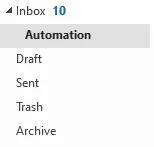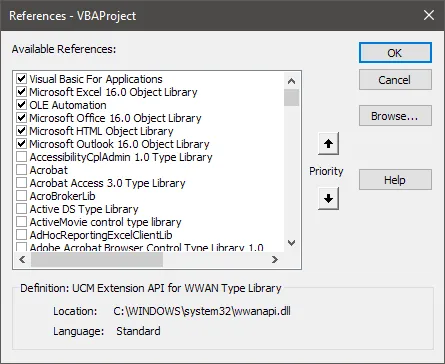Excel VBA: Automate E-mail Content Extraction from Outlook
In this scenario, Excel VBA is used to extract information from structured e-mails in Outlook using both text-based and HTML table-based methods. By automating the extraction process with VBA, data quality and accuracy are improved, and it is much faster than manually copying and pasting from each e-mail.
Text-based extraction uses the Replace and Split functions, while HTML table-based data is extracted using HTML object library functions.
Instructions
Structured E-mail Template
Automation depends on consistent, structured data. Each e-mail has the subject Template Email Subject and the body follows this format: The account for <Full Name> has been created., where <Full Name> represents the name associated with the created account. The e-mail body also includes a structured table with user details like Last Name, First Name, Company, Department, and Job Title.
The macro extracts the Full Name from the e-mail body and adds it to an Excel worksheet. It then extracts additional user details from the structured table and adds this information to the Excel worksheet.

Outlook Configuration
In Outlook, create a subfolder named Automation within the default Inbox to collect relevant e-mails. You can use an Outlook rule to automatically move these e-mails into the subfolder. Keeping the e-mails in a separate folder helps reduce the VBA search effort. In this example, the subfolder name Automation and its location in the default inbox are hard-coded. If the folder is created elsewhere, you will need to adjust the code accordingly.

Enable Libraries
To use this function, you must enable the Microsoft Outlook 16.0 Object Library (used to access and manipulate Outlook) and Microsoft HTML Object Library (used to traverse structured HTML). The version number varies based on the installed version of Microsoft Excel.
- From the
Developerribbon in Microsoft Excel, clickVisual Basic. - Once the
Visual Basic for Applicationswindow opens, go to theToolsmenu and selectReferences…. - From the
Referencesdialog box, check/enableMicrosoft Outlook 16.0 Object Library. - From the
Referencesdialog box, check/enableMicrosoft HTML Object Library. - Click the
OKbutton.

Add Source Code
The VBA code is added directly to ThisWorkbook within the Visual Basic for Applications window.
- From the
Developerribbon in Microsoft Excel, clickVisual Basic. - Once the
Visual Basic for Applicationswindow opens, selectThisWorkbookfrom theProject Explorerpane. - Add the following code.
Option Explicit
Public Sub ExtractDetailsFromOutlookFolderEmails()
On Error GoTo ErrorHandler
Dim OlApp As Outlook.Application
Dim OlNamespace As Namespace
Dim OlFolder As Folder
Dim OlItem As Object
Dim OlItemBody As String
Dim OlHtml As MSHTML.HTMLDocument
Dim HtmlElementCollection As MSHTML.IHTMLElementCollection
Dim HtmlElementTable As IHTMLElement
Dim TableRowIndex As Integer
Dim TableColIndex As Integer
Dim WsList As Worksheet
Dim ExcelRow As Integer
Dim ExcelCol As Integer
Dim FullName As String
Set WsList = ThisWorkbook.Sheets("Sheet1")
Set OlApp = CreateObject("Outlook.Application")
Set OlNamespace = OlApp.GetNamespace("MAPI")
Set OlFolder = OlNamespace.GetDefaultFolder(olFolderInbox) _
.Folders("Automation")
ExcelRow = 1
For Each OlItem In OlFolder.Items
If InStr(OlItem.Subject, "Template Email Subject") > 0 Then
ExcelCol = 1
OlItemBody = Replace(OlItem.Body, "The account for", _
"####################")
OlItemBody = Replace(OlItemBody, "has been created.", _
"####################")
FullName = Trim(Replace(Replace( _
Replace(Split(OlItemBody, "####################")(1), _
Chr(10), ""), Chr(12), ""), Chr(13), ""))
WsList.Cells(ExcelRow, ExcelCol) = FullName
Set OlHtml = New MSHTML.HTMLDocument
OlHtml.body.innerHTML = OlItem.HTMLBody
Set HtmlElementCollection = OlHtml.getElementsByTagName("table")
For Each HtmlElementTable In HtmlElementCollection
For TableRowIndex = 0 To HtmlElementTable.Rows.Length - 1
For TableColIndex = 0 To _
HtmlElementTable.Rows(TableRowIndex).Cells.Length - 1
On Error Resume Next
If TableColIndex Mod 2 = 1 Then
ExcelCol = ExcelCol + 1
WsList.Cells(ExcelRow, ExcelCol).Value = _
HtmlElementTable.Rows(TableRowIndex).Cells(TableColIndex).innerText
End If
On Error GoTo ErrorHandler
Next TableColIndex
Next TableRowIndex
Next HtmlElementTable
ExcelRow = ExcelRow + 1
End If
Next OlItem
Exit Sub
ErrorHandler:
If Err.Number <> 0 Then
MsgBox "Error extracting details. [ExtractDetailsFromOutlookFolderEmails]"
End If
End SubCode Description
This code has been tested with Microsoft Office Professional Plus 2019 using the described e-mail template and Outlook configuration. It includes hard-coded values that must be updated for different e-mail templates and configurations, such as the Excel worksheet name (Sheet1), and the Outlook subfolder name (Automation) and location.
The code connects to Outlook and accesses a subfolder named Automation in the default inbox, which holds all the structured e-mails.
It then loops through each e-mail in the subfolder, checking for those with the subject containing Template Email Subject.
For text-based information extraction, the code replaces specific phrases (The account for and has been created.) in the e-mail body with ####################. This common delimiter makes it easier to extract the text between them. For example, the modified body would look like this:
############## <Full Name> ##############The code uses the Split function to extract the text between these delimiters and removes any extra whitespace, line feeds, form feeds, and carriage returns using the Trim and Replace functions. The cleaned text is then written to Column A of Sheet1.
For HTML table-based extraction, the code references the HTML table tag in the e-mail body using getElementsByTagName. It loops through the table rows and columns to collect data from the second column, ignoring the first column which contains headers.
Execute Procedure
- From the
Developerribbon in Microsoft Excel, clickMacros. - The
Macrodialog box opens. SelectExtractDetailsFromOutlookFolderEmails - Click the
Runbutton to execute the procedure.

Results
After running the procedure, the worksheet is filled with information from both the text-based and table-based methods. This example tested with only one e-mail, but if there were multiple e-mails in the Outlook subfolder, the sheet would have an additional row for each e-mail.

Summary
This scenario demonstrates how VBA can automate data extraction from structured e-mails in Outlook to an Excel worksheet, enhancing data quality and processing speed compared to manual methods. The process involves two extraction techniques: a text-based method using string manipulation functions and a structured table-based extraction using HTML object library functions.